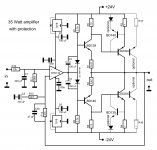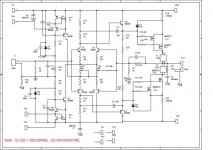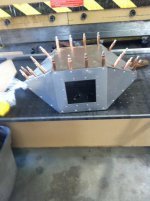Spatial information integrity, distortion, compression, whatever is available related to reproduction of source localization information in 3D space.
Define "spatial information integrity" when the spatial information is synthetic in the first place. "What the studio intended" doesn't cut it...
I already explained that there were some practical aspect involved in an older post, he actually improved the thermal regime by far in class ab which matters the most with any class ab amplifier, he never killed a speaker , but he is not a leader in touring industry just for being cheap.Maybe he was being cheap and wanted a way to eliminate output transistor mica washers 😉.
Dan.
I had this talk about the exponential discharge of the capacitors in qsc 12 years ago with a friend who's heads and shoulders above me in electronics, and the most interesting thing for me was that exponential law predicts a faster charge and discharge than the speaker can ask from the system in the base region where most of the energy is spent.The only enemy is the internal resistance of the power transformer and the L(of the transformer secondary )C tank behavior will dominate the whole system .
Most amplifiers would have hundreds to thousands of v/us slew rates before the final stage and then all that slew rate would be killed by slow final transistors in unity gain because of the BE junction capacitance which is actually the one who needs to be compensated in the first place through the feedback network or feed forward techniques or nested feedback to make all the preceding stages be in phase with the output.
Some few amps used high FT transistors in the final stage and they solved the problems much easier.
QSC regulates the slew rate in the output stage and makes the compensation much easier. Its very clear that at that power level that they sell you can't get any simpler circuit than QSC and they are known for being the most reliable amps in the industry too...
Last edited:
And by the way there's a pretty interesting project in the diy high end world inspired by QSC:
https://www.by-rutgers.nl/SSA35.html
I think that you can get all the useful ideas from there.
Gain in the final stage isn't a new idea anyway and one other notable project more on this : the Gregg ball ska-150 project:
https://www.diyaudio.com/forums/solid-state/238593-ska-gb150d-public-domain-18.html#post3643674
https://www.by-rutgers.nl/SSA35.html
I think that you can get all the useful ideas from there.
Gain in the final stage isn't a new idea anyway and one other notable project more on this : the Gregg ball ska-150 project:
https://www.diyaudio.com/forums/solid-state/238593-ska-gb150d-public-domain-18.html#post3643674
Attachments
Last edited:
Define "spatial information integrity" when the spatial information is synthetic in the first place. "What the studio intended" doesn't cut it...
Yeah, in the end you just need to compare input to output if we’re talking electronics. I read the initial reply and decided it’s not even worth engaging.
Let-me answer:
1- Ok, put a mike in front of your speaker at your listening point. Play 5 sec of music and record-it. Compare the wave forms with the original source. Just think about this.
2- Don't you understand the difference between "Sound bad" and "sound different" ? This said, I use ICs that I prefer to a lot of discrete circuits. My system, apart some power amps, is entirely IC based.
3- To be able to discriminate something with our hearing is not a question of response curve. It is a question of culture. (Your wife's face in a crowd).
By example, lot of people listen to music vertically. Musicians listen horizontally : the play of each instrument. Most of people do not know the sound of the instruments. How many are able to make the difference between a Steinway and a Bechstein ? A Gibson 335 and a Fender telecaster ?
How many people have any knowledge about how is supposed to sound a track, so how can they judge of their defects ?
How many system are able to reproduce all the details in a recording, micro dynamic, separation etc ?
A little game, to illustrate how we can listen differently, depending on our culture:
hcj.mp3
Not a little detail, but something enormous that will enjoy all the musicians or people with a musical culture here.
I will give the solution later.
So flawed I don’t know where to begin. Anyway this discussion will go nowhere so I’m out. I think we just have a fundamental misunderstanding of what each of us were originally getting at.
Last edited:
The only true thing is that, indeed, musicians know what they listen a bit more accurately than others.This aspect was pointed out by a friend of mine who runs touring equipment for a decade now and who says that most musicians don't recognize their instruments on SSL9000 equipment. He asked me at some point: what makes you think hearing that Peter Gabriel used a ssl 8000 in his concerts all the time while owning SSL?
As I said, a man, at least I, can locate a sound source in 3D. I set my expectation too high when chris719 said that he believes anything audible is measurable.Define "spatial information integrity" when the spatial information is synthetic in the first place. "What the studio intended" doesn't cut it...
Nope, you were talking about measurement of anything audible. The way you made the statement I thought you did know something. Oh well... 😉Yeah, in the end you just need to compare input to output if we’re talking electronics. ...
Last edited:
... You cannot improve vox ac 30, nor you can improve any guitar equipment as it was made with a clear purpose the way it was done.Artists are looking more into the novelty of a sound than into the technical aspects.
Yes and no.
Actually most famous guitar amps are "improvements" of one another. The basic circuitry is simple: 1 or 2 triode preamp, a tone stack, and a LTP driving a push-pull output stage. The foundation was laid in 1946 with the Fender Tweed series, and the 1956 Fender Bassman 5F6 was elevated to Holy Grail status, and so became an "inspiration" to everybody else.
Marschall promptly cloned the circuit with some tweaks in the tone stack and EL34's instead of 6L6's, Vox chose to use self-bias with EL84's, Mesa Boogie added an extra preamp stage for distortion, etc..., all the way to the very exclusive Dumble who only agreed to sell you his amp if he liked your playing!
"Plus ça change et plus c'est la même chose", but the devil is in the detail.
As I said, a man, at least I, can locate a sound source in 3D. I set my expectation too high when chris719 said that he believes anything audible is measurable.
Nope, you were talking about measurement of anything audible. The way you made the statement I thought you did know something. Oh well... 😉
It probably is, but my comments are all regarding electronics. Anyway, responding to this any further is a waste of everyones time.
Yes and no.
Actually most famous guitar amps are "improvements" of one another. The basic circuitry is simple: 1 or 2 triode preamp, a tone stack, and a LTP driving a push-pull output stage. The foundation was laid in 1946 with the Fender Tweed series, and the 1956 Fender Bassman 5F6 was elevated to Holy Grail status, and so became an "inspiration" to everybody else.
Marschall promptly cloned the circuit with some tweaks in the tone stack and EL34's instead of 6L6's, Vox chose to use self-bias with EL84's, Mesa Boogie added an extra preamp stage for distortion, etc..., all the way to the very exclusive Dumble who only agreed to sell you his amp if he liked your playing!
"Plus ça change et plus c'est la même chose", but the devil is in the detail.
I know all these aspects.I spent all my spare time for 5 years doing this sport...i still have a cubic meter of valve amps schematics on paper as at the time ididn't have a computer of my own...Vox ac 30 ows his sound almost entirely to el84 valve.
Tweaking cannot be called anything but...tweaking.That is why we have so many guitar amp models done by people who doesn't have a clue of how a valve or even a diode works.
Here you have my last toy i made 10 years ago:
Image - TinyPic - Free Image Hosting, Photo Sharing & Video Hosting
http://oi51.tinypic.com/2dhcnt5.jpg
tried to sell it on a specialized forum.now i'm really amused reading my own explanation about the possible improvements i was offered to clients by changing the valves as i have condensed 3 Marshall preamps drive types and a Mesa with a continuous variable drive level , which was not present in Mesa, but it had no head amp and the sound was completely different and harder to tame...You could hardly find a preamp giving 19 sound mods like mine, but it was useless cause most guitar players couldn't understand how it works at all...Thank God some people liked it and i could sell it...There were some flaws in the design as i didn't really understand lots of things at the time...now i can't go back in time, that diy guitar sport is dead in my country as the prices dropped a lot in the area.
Last edited:
Not my intent, just addressing the "I hear what I hear, I don't need any controlled listening, I've been doing this this way for 40yr. and it works, I don't need to prove anything to anyone", etc., etc. crowd.Are you by any chance being ironic here?
This will only happen if the amp gain depends significantly on supply rail voltage.Tournesol said:I believe that one of the reasons why some people prefer unregulated power supplies in their amps is the fact that, in presence of a violent dynamic attack, the capacitances will discharge and the output voltage of the power supply will decrease. It will help to increase the dynamic of this attack, that is often flatten in the the all process that brings the original sound to your ears (Mics and speakers included).
An unregulated supply means a slightly higher headroom for occasional signal peaks. This may be audible.
Indrawan. Your question about measuring spatial cues in recorded music doesn't really make much sense to me. Anyway, I'm sure you know that those cues can be both recorded by the mic, if there is one, and/or created synthetically, they only need reproducing, I may be missing your point.
I don't understand why so much audio amateurish here are, as it seems, on the objectivists side. Apart it is a reassuring position because over simplifying.ANope, you were talking about measurement of anything audible. The way you made the statement I thought you did know something. Oh well... 😉
I remark that most of the experienced professionals, here, are much more nuanced about this subject.
-Measurements quantify, hearing qualify.
-We ordinary measure with continuous signals, we listen music, made of permanent changing signals and our ears and brain are more sensible to transients.
-We don't know so much how to correlate what we measure with what we "feel". (We know very few things about psycho acoustic.)
-Measurements will never give-us an answer about what we are not looking for. Hearing can do.
And, most of all, all this stuff is made to allow-us to enjoy music, played by totally subjective and biased people (musicians) recorded with imperfect devices (Mics) , by flawed people (sound engineers and producers) mixed with devices designed to *hardly* distord the signals (EQ, Reverb etc.), and reproduced by speakers that are all what we want but linear (including in the time domain) in a room that has nothing to do with the place the musicians were playing.
Why the hell some would want to walk in strait line in mountains ?
Records are made to be enjoyable reproducing systems to bring the pleasure that we are looking for, which can be different different from one to an other listener. Hifi is made to be listened, like photography to be watched.
Measurements are only an help to the designers, to dig a special parameter during a work, and look more deeper in it than he can do by its unique senses, in a totally objective manner.
They will never say a lot to the customer about the character of a device he want to buy, and the way it will integrated in his own system, compensating or increasing its flaws.
We only can eliminate gears that, obviously, measure terrifically bad.
And for the people that are convinced (so strange, when we have ears) that everything that measure good enough sound the same: happy they are, they just have to order the cheapest devices on catalogues and let other people free to have different opinions based on their... real experiences.
Real experiences in the real life of our whole univers where nothing, nothing is never exactly the same.
But the worse, is that those same people come here, in loop, to give lessons of professional correctness to ... professional people that had spend their all life in Audio industry. Lessons they've probably read in an article of some reader's digest selection book entitled: "How to get rid of snake oil and not be swayed by hifi dealers and audio myths.".
(Probably co-signed by D.S. ;-)
BORING.
Last edited:
Yes Scott, a recording can sound holographic and others are flat on playback. I thought that aspect has become measurable because it is audible, but apparently ... 🙂... you know that those cues can be both recorded by the mic, if there is one, and/or created synthetically, they only need reproducing, I may be missing your point.
- Status
- Not open for further replies.
- Home
- Member Areas
- The Lounge
- John Curl's Blowtorch preamplifier part III




